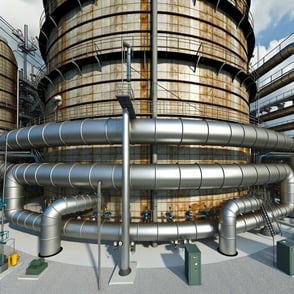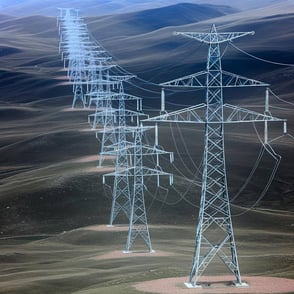Flow Batteries
Flow batteries store energy in liquid electrolytes within external tanks, offering scalable, long-cycle energy storage for grid stability, renewable integration, and backup power systems.
What are Flow Batteries?
Flow batteries are a type of chemical energy storage where energy is stored in liquid electrolytes contained within external tanks. Unlike conventional batteries, the electrochemical reactions in flow batteries occur in the liquid state, which flows through a cell stack where the energy conversion takes place. This design allows for easy scalability and long cycle life, making flow batteries particularly suitable for large-scale energy storage applications such as grid storage, renewable energy integration, and backup power systems.
How Flow Batteries Work
Flow batteries consist of two main components: the electrochemical cell stack and the external storage tanks. The electrolytes are stored in separate tanks, one for the positive electrolyte (catholyte) and one for the negative electrolyte (anolyte). These liquids contain dissolved electroactive species that participate in the redox reactions to store and release energy. The cell stack is where the electrochemical reactions occur. It contains multiple cells, each with an anode, a cathode, and a membrane or separator that allows ions to pass while preventing the mixing of electrolytes.
During charging, an external power source drives the electroactive species in the electrolytes to undergo oxidation and reduction reactions at the anode and cathode, respectively. This process stores energy by converting the chemical state of the electrolytes. In the discharging phase, the stored chemical energy is converted back into electrical energy. The redox reactions are reversed: the oxidized species in the anolyte are reduced, and the reduced species in the catholyte are oxidized. This flow of electrons through the external circuit generates electricity, providing power to connected devices or the grid.
Flow batteries are categorized based on the types of electrolytes used and the specific redox reactions they utilize. Vanadium redox flow batteries (VRFB) use vanadium ions in different oxidation states for both the anolyte and catholyte. VRFBs are known for their high efficiency, long cycle life, and scalability. They are widely used in grid storage and renewable energy applications. Zinc-bromine flow batteries (ZBFB) use a zinc-based anolyte and a bromine-based catholyte. Zinc-bromine flow batteries offer high energy density and are often used in applications requiring compact and flexible energy storage solutions. Iron-chromium flow batteries (ICFB) use iron and chromium electrolytes. They are known for their low cost and safety, making them suitable for large-scale energy storage applications where cost is a critical factor. Hybrid flow batteries combine elements of traditional batteries and flow batteries. They use a solid electrode for one half-cell reaction and a flowing electrolyte for the other. This design can enhance energy density and performance.

The Impact of Flow Batteries on the Energy Sector
Flow batteries are used in a variety of applications due to their scalability, long cycle life, and flexibility. Flow batteries provide large-scale energy storage solutions for electric grids. They help balance supply and demand, provide backup power, and support load leveling and frequency regulation. Their ability to store large amounts of energy for extended periods makes them ideal for stabilizing the grid and integrating renewable energy sources. Like other storage systems, flow batteries support the integration of intermittent renewable energy sources. They store excess energy generated during peak production times and release it during periods of low generation, ensuring a stable and reliable power supply.
Flow batteries are used in uninterruptible power supplies (UPS) and other backup power systems to provide reliable power during grid outages. Their long cycle life and high reliability make them suitable for critical infrastructure such as data centers, hospitals, and telecommunications networks. They are also used in various industrial and commercial applications to manage energy use, reduce peak demand charges, and enhance energy security. They provide a flexible and scalable solution for facilities with high energy consumption.
Flow batteries use non-toxic and recyclable materials, making them an environmentally friendly energy storage option. Their deployment supports the transition to cleaner energy sources and reduces greenhouse gas emissions.
Conclusion
Flow batteries represent a versatile and scalable solution for modern energy storage needs. Their unique design, which separates energy storage capacity from power output, offers unparalleled flexibility and efficiency for large-scale applications. By supporting grid stability, facilitating renewable energy integration, and offering long-lasting performance, flow batteries play a crucial role in advancing a sustainable and reliable energy future.
Glossary
- Electrochemical Cell Stack: The part of a flow battery where electrochemical reactions occur, consisting of electrodes and a membrane separator.
- External Storage Tanks: Tanks that hold the liquid electrolytes used in flow batteries.
- Electrolytes: Liquid solutions containing electroactive species that participate in redox reactions to store and release energy.
- Catholyte: The electrolyte containing the electroactive species for the positive electrode (cathode) reactions.
- Anolyte: The electrolyte containing the electroactive species for the negative electrode (anode) reactions.
- Vanadium Redox Flow Battery (VRFB): A type of flow battery that uses vanadium ions in different oxidation states for energy storage.
- Zinc-Bromine Flow Battery: A type of flow battery that uses zinc and bromine as the electroactive species.
- Iron-Chromium Flow Battery: A type of flow battery that uses iron and chromium as the electroactive species.
- Redox Reactions: Chemical reactions involving the transfer of electrons between species, resulting in changes in oxidation states.
- Grid Storage: The use of energy storage systems to balance supply and demand, provide backup power, and support grid stability.
- Renewable Energy Integration: The process of incorporating renewable energy sources such as solar and wind power into the energy grid.
- Backup Power Systems: Systems that provide reliable power during grid outages, ensuring the continuity of critical operations.
- Load Leveling: The process of storing energy during low demand periods and releasing it during high demand periods to balance the load on the grid.
.png?width=200&height=80&name=etpa-logo-color%20(1).png)































.png)
.png)
-1.png?width=250&height=100&name=etpa-logo-color%20(1)-1.png)